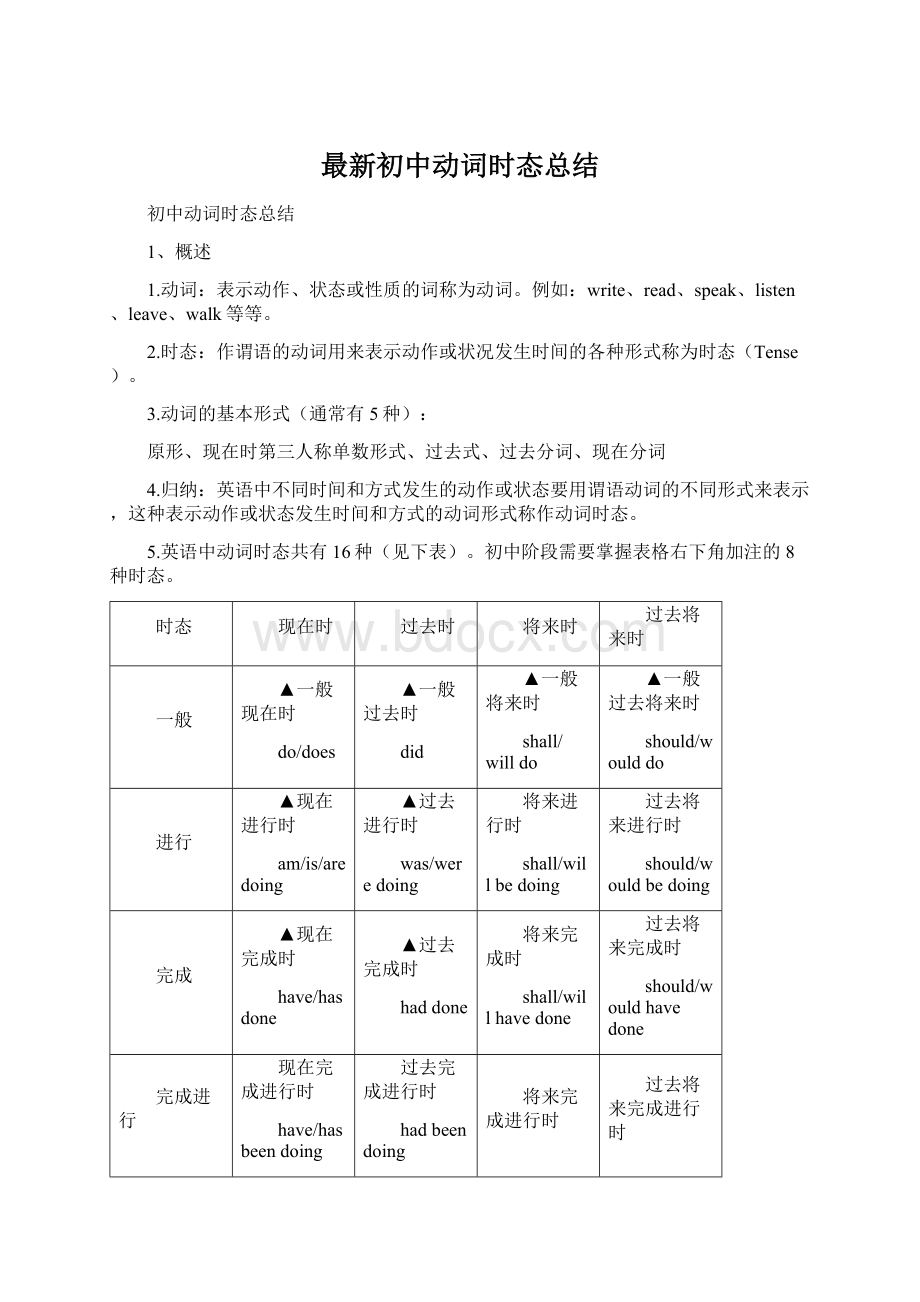最新初中动词时态总结.docx
《最新初中动词时态总结.docx》由会员分享,可在线阅读,更多相关《最新初中动词时态总结.docx(14页珍藏版)》请在冰豆网上搜索。

最新初中动词时态总结
初中动词时态总结
1、概述
1.动词:
表示动作、状态或性质的词称为动词。
例如:
write、read、speak、listen、leave、walk等等。
2.时态:
作谓语的动词用来表示动作或状况发生时间的各种形式称为时态(Tense)。
3.动词的基本形式(通常有5种):
原形、现在时第三人称单数形式、过去式、过去分词、现在分词
4.归纳:
英语中不同时间和方式发生的动作或状态要用谓语动词的不同形式来表示,这种表示动作或状态发生时间和方式的动词形式称作动词时态。
5.英语中动词时态共有16种(见下表)。
初中阶段需要掌握表格右下角加注的8种时态。
时态
现在时
过去时
将来时
过去将来时
一般
▲一般现在时
do/does
▲一般过去时
did
▲一般将来时
shall/willdo
▲一般过去将来时
should/woulddo
进行
▲现在进行时
am/is/aredoing
▲过去进行时
was/weredoing
将来进行时
shall/willbedoing
过去将来进行时
should/wouldbedoing
完成
▲现在完成时
have/hasdone
▲过去完成时
haddone
将来完成时
shall/willhavedone
过去将来完成时
should/wouldhavedone
完成进行
现在完成进行时
have/hasbeendoing
过去完成进行时
hadbeendoing
将来完成进行时
shall/willhavebeendoing
过去将来完成进行时
should/wouldhavebeendoing
2、一般现在时
1.通常用法:
表示经常发生的或习惯性的动作,或目前的特征或状态。
2.常用的时间状语:
often、usually、sometimes、inspring、everyday、inthemorning,at+具体时间。
3.构成:
1)动词原形(主要),如:
work;
2)第三人称单数形式,如:
works;
3)be&have,特殊的人称形式,随主语变化,如:
am/is/are,have/has.
4)一般疑问句构成及简答:
Do+主语+动原+其它?
Yes,Ido./No,Idon’t.
Does+主语+动原+其它?
Yes,hedoes./No,hedoesn’t.
Be+主语+其它?
Yes,Iam./No,I’mnot.
5)特殊疑问句举例:
Whatdoyouoftendoonsundays?
Wheredoeshelive?
4.具体用法:
1)目前经常性或习惯性的动作,常与表示频度的时间状语连用。
Igotoworkonfooteveryday.
SheoftenspeaksEnglish,soherEnglishisverynice.
2)客观真理,客观存在,科学事实。
Theearthgoesroundthesun.
QuzhouliesinthesouthwestofHangzhou.
3)一个按规定、计划、安排要发生的动作,仅限于少数动词,如:
begin,come,leave,go,start等。
Thetrainleavesat8:
15.
4)表示格言或者警句中。
Pridegoesbeforeafall.(骄者必败)
注意:
此用法如果出现在宾语从句中,即使主句是过去时,从句谓语也要用一般现在时。
例:
Columbusprovedthattheearthisround.
5)现在的特征、状况或能力。
Guomingyiisalwaysreadytohelpothers.
LileiwritesgoodEnglishbutdoesnotspeakwell.
6)主将从现﹝主句用将来时从句用现在时﹞
Iwilltellyou,WhenLiMingcomes.
I'lle-mailyouassoonasIgettoBeijing.
注:
一般从句为时间状语从句「由When/Assoonas...引导的从句」条件状语从句「由If...引导的从句」
7)在“时间、条件、方式、让步”等状语从句中表示“将来”的动作或状况。
Ifitdoesn’traintomorrow,ourcompanywillstartbusiness.
8)在某些以here、there开头句子中用一般现在时表示现在正在或已经发生的动作。
Hereweareatlast!
(我们终于到了)
9)用于电影、电视、戏剧、图文、标题等的解说或介绍。
Jeanneissittinginthepark.Mathildewalkstowardsher.(剧本说明)
5.练习题:
1)._________Aliceoftenplaythepiano.No,she__________.
A.Do;doB.Does;doesC.Does;doesn’t
2).________yourpenfriend_______inBeijing?
A.Do;liveB.Do;livesC.Does;live
3.TomandMike_______veryexcited,theywilltakeatrip.
A.isB.areC.am
4.Ilike________verymuch.Whataboutyou?
A.danceB.dancedC.dancing
5.Ican’tfindmypen.Letme_______.
A.goandaskherB.goandaskhersC.goandaskshe
答案:
CCBCA
3、一般过去时
1.通常用法:
过去的习惯动作或过去某时发生的动作或状态。
2.常用的时间状语:
yesterday、anhourago、lastnight、twodaysago、in2012、atthattime、beforeliberation(解放)、when等引导的含过去时的句子。
3.构成:
1)动词过去式(did),如:
worked/usedtowork;
2)否定构成:
didn’t+动原,如:
didn’twork/usednot(didn’tuse)towork;
3)一般疑问构成及简答:
Did+主语+动原+其它?
Yes,Idid./No,Ididn’t.
Was/Were+主语+其它?
Yes,shewas./No,shewasn’t.
4)特殊疑问句举例:
Whatdidyoudoyesterday?
Whendidhegetupthismorning?
4.具体用法:
1)在确定的过去时间里所发生的动作或存在的状态。
Wheredidyougojustnow?
2)表示在过去一段时间内,经常性或习惯性的动作。
WhenIwasachild,Ioftenplayedfootballinthestreet.
SheoftencametohelpmewithmyEnglish.
3)在“时间、条件、方式、让步”等状语从句中表示“过去将来”。
Theyplannedtogooutingifitwasfinethenextday.
4)在虚拟语气中,可表示“现在、将来”的动作或状态。
WereIyou(=IfIwereyou),Iwouldgoabroad.
5)在谈到已逝的人的情况(包括后人对他们的评价)多用一般过去时。
Newtonwasagreatscientist.
6)用“usedto+动原”或用“would+动原”,可表示过去经常或反复发生的动作。
Wheneverwewereintrouble,hewouldhelpus.
ThatiswhereIusedtolivewhenIwasachild.
5.练习题:
1).I_____acartoononSaturday.
A.watchB.watchedC.watching
2).We______tozooyesterday,andwealso_____tothepark.(go)
A.go;goB.went;goC.went;went
3)._____you_____yourrelativeslastSpringFestival?
A.Did;visitB.Does;visitC.Do;visit
4).ThetwinsinDalianlastyear.Theyherenow.
A.was;areB.were;areC.are;are
5).——WhowasondutylastFriday?
——.
A.IamB.IwasC.Yes,Iwas.
答案:
BCABB
4、现在进行时
1.通常用法:
现在或现阶段正在进行的动作。
2.常用时间状语:
now、thesedays。
3.构成:
1)is(am,are)+现在分词,如:
am/is/areworking.
2)否定构成:
is(am,are)+not+现在分词,如:
am/is/arenotworking.
3)一般疑问构成及简答:
Am/Is/Are+主语+现在分词+其它?
Yes,Iam./No,I’mnot.
4)特殊疑问句举例:
Whatareyoudoingnow?
Whoisflyingakitethere?
注意:
go、come、leave、arrive、return、die等的进行时可表示即将要发生的动作。
4.具体用法:
1)说话时正在发生或者进行着的动作。
Whatareyoudoingnow?
--I’mdoingmymathshomework.
2)表示现阶段在进行的动作(说话时不一定在进行)。
Areyouworkinghardthisterm?
Mr.Greeniswritinganothernovel. (说话时并未在写,只处于写作的状态。
)
3)表示即将发生的动作,尤其是表示按“计划”或“安排”要进行的动作。
WhenareyougoingofftoShenzhen?
4)表示反复性或习惯性的动作,常与副词always、constantly、continually连用,常带有说话的某种感情色彩,如:
赞扬、厌恶、不满、遗憾等。
Sheisalwaysthinkingofherson.
Languageisalwayschanging.
5)表示情况的暂时性。
Charlieisn’tfeelingtoowellthismorning.(平时不这样)
6)be动词有时可用于进行时态,表示“一时的表现”。
Youarenotbeingfriendly.(你这样说不够友好)。
7)表示渐变的动词有:
get、grow、become、turn、run、go、begin等。
Theleavesareturningred.
It'sgettingwarmerandwarmer.
注意:
不用进行时的动词
1)事实状态的动词
have,belong,possess,cost,owe,exist,include,contain,matter,weigh,measure,continue
例如:
Ihavetwobrothers.
Thishousebelongstomysister.
2)心理状态的动词
know,realize,think,believe,see,suppose,imagine,agree,recognize,forget,
remember,want,need,prefer,mean,understand,love,hate
例如:
Ineedyourhelp.
Helovesherverymuch.
3)瞬间动词
accept,receive,complete,finish,give,allow,decide,refuse.
例如:
Iacceptyouradvice.
4)系动词
seem,remain,lie,see,hear,smell,feel,taste,get,become,turn
例如:
Youseemalittletired.
5.练习题:
1).Who_____overtherenow?
A.singingB.aresingC.issingingD.sing
2).It’seighto’clock.Thestudents_____anEnglishclass.
A.haveB.havingC.ishavingD.arehaving
3).Listen!
Thebaby_____inthenextroom.
A.cryingB.criedC.iscryingD.cries
4).Look!
Thetwins_____newsweaters.
A.arewearingB.wearingC.arewearD.iswearing
5.Don’ttalkhere.Grandparents_____.
A.issleepingB.aresleepingC.sleepingD.sleep
答案:
CDCAB
5、过去进行时
1.通常用法:
表示在过去某一时刻或某一时间正在进行的动作,强调在这一过程中所进行的动作或展开的情景。
2.常用时间状语:
atthistimeyesterday、atthattime、fromninetotenlastevening、when/while引导的从句。
3.构成:
1)was/were+现在分词,如:
was/wereworking.
2)否定构成:
was/werenot+现在分词,如:
wasn’t/werenotworking.
3)一般疑问构成及简答:
Were/Was+主语+现在分词+其它?
Yes,Iwas./No,Iwasn’t.
4)特殊疑问句举例:
Whatwereyoudoingthistimeyesterday?
Wherewashestandingwhentheteachercamein?
4.具体用法:
1)表示过去某一时刻正在进行着的动作。
Mostofthepeoplewerestillsleepingwhentheearthquakehappened.
2)表示过去某一阶段在进行的动作。
Lastmonththeywerebuildingabridgeoverariverintheirhometown.
3)表示过去即将发生的动作。
Sheaskedhimwhetherhewascomingbackforlunch.
4)表示过去的反复性或习惯性的动作,常与副词always、constantly、continually、frequently等连用,常带有说话人的某种感情色彩。
Herfatherwasalwaysworkinglikethat.
5)可用来描写故事发生时的背景。
Itwasdarkandastrongwindwasblowing.
5.练习题:
1).Mybrother___whilehe___hisbicycleandhurthimself.
A.fell,wasridingB.fell,wereriding
C.hadfallen,rodeD.hadfallen,wasriding
2).Tom___intothehousewhennoone___.
A.slipped,waslookingB.hadslipped,looked
C.slipped,hadlookedD.wasslipping,looked
3).ThelasttimeI__Janeshe___cottoninthefields.
A.hadseen,waspickingB.saw,picked
C.hadseen,pickedD.saw,waspicking
4).Idon'tthinkJimsawme;he___intospace.
A.juststaredB.wasjuststaring
C.hasjuststaredD.hadjuststared
5).IfirstmetLisathreeyearsago.She___ataradioshop(无线电商店)atthe
time.
A.hasworkedB.wasworking
C.hadbeenworkingD.hadworked
答案:
AADBB
6、一般将来时
1.通常用法:
将来发生的动作或状况。
2.常用时间状语:
tomorrow、nextyear/month、inafewofminutes、tonight等。
3.构成:
1)shall/will+动原,如:
shall/willwork;
2)am/is/aregoingto+动原,如:
am/is/aregoingtowork;
3)am/is/are(about)to+动原,如:
am/is/are(about)towork;
4)否定构成:
shall/willnot+动原,如:
shall/willwork.
am/is/arenot...
5)特殊疑问句举例:
Whatwillyoudotomorrow?
Whenarewegoingtohaveaclassmeeting?
4.具体用法:
1)表示将要发生的动作或状态。
Xiaomingshallbeelevenyearsoldnextyear.
Shewon’tbefreetonight.
2)表示一种倾向性或习惯性的动作。
Peoplewilldiewithoutair.
3)其他表示将要发生的动作或情况的结构和时态。
am/is/aregoingto+动原.——该结构表示“即将发生”或“打算要做”某事。
Ithinkitisgoingtorain.
Heisgoingtofindapart-timejobforayearortwoandsavesomemoney.
am/is/areto+动原.——该结构表示(按计划、安排)“要求”、“约定”、“必须”做某事。
Theyaretobebackby6o’clock.
Youaretohandyourhomeworktomorrow.
am/is/areaboutto+动原.——该结构表示“即将”、“就要”做某事。
Weareabouttogohome.
Weareabouttosendleaflets(宣传页).
5.练习题:
1).There__________ameetingtomorrowafternoon.
A.willbegoingtoB.willgoingtobe
C.isgoingtobeD.willgotobe
2).Charlie________herenextmonth.
A.isn’tworkingB.doesn’tworking
C.isn’tgoingtoworkingD.won’twork
3).He________verybusythisweek,he________freenextweek.
A.willbe;isB.is;is
C.willbe;willbeD.is;willbe
4).Mother________meanicepresentonmynextbirthday.
A.willgivesB.willgive
C.givesD.give
5).–________you________freetomorrow?
–No.I________freethedayaftertomorrow.
A.Are;goingto;willB.Are;goingtobe;will
C.Are;goingto;willbeD.Are;goingtobe;willbe
答案:
CDDBD
7、过去将来时
1.通常用法:
表示从过去某时看来将要发生的动作或状态。
2.常用时间状语:
thenextday、thenextweek.
3.构成:
1)should/would+动原,如:
should/wouldwork;
2)was/weregoingto+动原,如:
was/weregoingtowork;
3)was/were(about)to+动原,如:
was/were(about)towork;
4)否定构成:
should/wouldnot+动原,如:
should/wouldnotwork;
was/werenot...
5)一般疑问构成:
常用If或Whether引导宾语从句。
6)特殊疑问句举例:
Heaskedwhattheywouldthenextweek.
4.具体用法与一般将来时相似,但时间基点是“过去”,不再具体论述。
Hesaidhewouldjoinusinplayingbasketballifhehadtime.
Shewasabouttoleavewhenthetelephonerang.
Hesaidhewasgoingtohaveatry.
Itoldhert